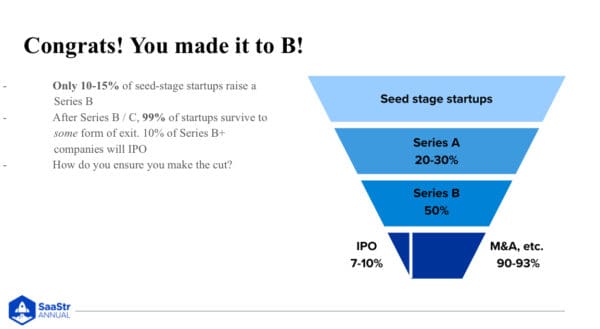
How do you raise funds beyond Series B? If you’ve made it that far, congrats! You’re one of the lucky 15% that raised seed funding and made it to Series B. It also means you’re highly likely to get an exit at some point. There’s only a small chance that it’ll be an IPO exit, and Stacey Bishop with Scale Ventures shares what it takes to get to that next level of funding.
Typical Fundraising Paths
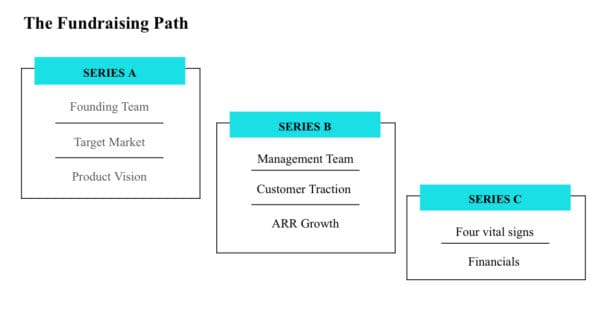
You may have already raised your series A and B, and you’ve got a sense that it’s a different process each time. Series A is typically about the founding team, target market, and product vision.
In Series B, investors dive deeper into the management team, where they try to assess the founding team’s ability to attract and keep great talent on board. Customer traction is key. Of course, ARR growth comes into play as well.
By the time you get to Series C, investors aren’t asking a lot about the founding team or product vision. They want to know all about the numbers and what’s taking off. In this article, you’ll learn about the 4 vital signs investors are looking for:
- Revenue growth
- Sales efficiency
- Churn
- Cash burn
When you’re at $0-$5M in revenue, most of your investment goes into product. But that shifts over time, and most of your spend goes into sales and marketing. Once you’re at $10M ARR, more than half of your spend goes to sales and marketing, so you want to optimize that spend.
You’ve Raised a Series B. What’s Next?
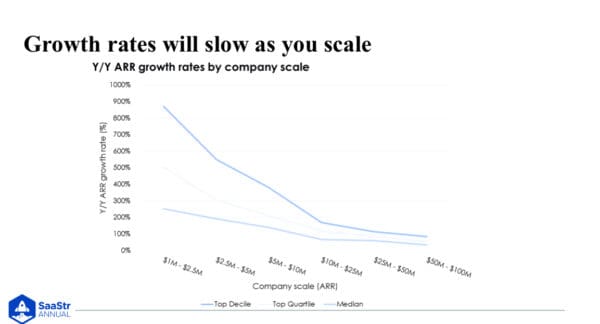
When starting out, growth rates are super high, like 900%, which is insane. Over time, those rates do come down quite a bit, but there’s still a minimum level of growth you need in order to raise funding.
Minimum Level of Growth
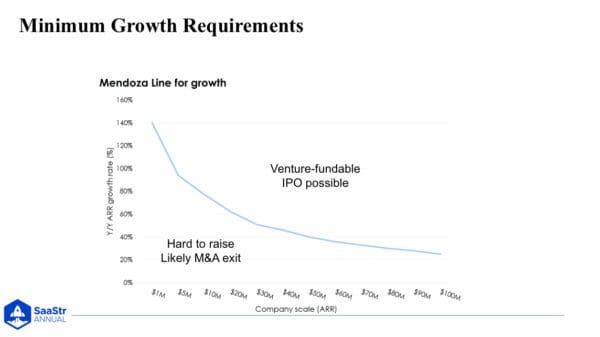
For the baseball fans, Stacey gives the example of Mario Mendoza. The minimum batting average he had to have was 200, and he fell below that. What does that mean for VC growth? To get VC to put money into your company, Scale Ventures looked at and calculated the minimum level of growth based on what typical venture investors require.
Typically, a 30% public company trades at about a 6x revenue multiple. So, projecting out to the future, that minimum level of growth will go down. For example, if you’re growing 100% this year, next year you’ll grow 85% of that. Then 72.5%. It declines over time.
Say, for example, you’re a $10M ARR company. You need at least an 80% growth rate at that time to attract VC funding. At $20M ARR, it’s about 55% and goes down from there. But you can’t fall much below 30% because you fall off the IPO trajectory if that’s what you want.
If you aren’t at that growth rate, you need to look at the level of cash you have on hand and make it last as long as possible. You want to get to cash flow-break even. If you don’t have a line of sight to cash flow-break even, Stacey suggests a company six months away from running out of cash to start looking for an exit.
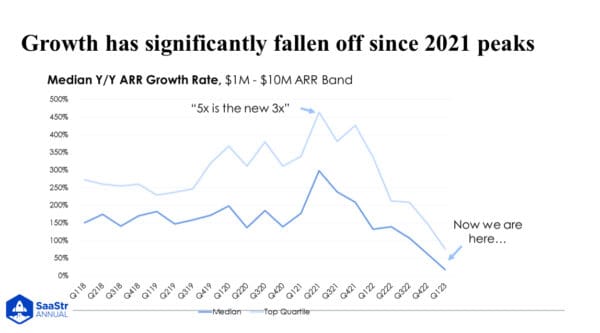
They’ve seen some great exits where they had 3-4 years in a row of 40% growth. It’s also worth noting that growth has fallen off significantly from 2021. Around 2018, the top company was around 4x, with the median around 3x between $1M-$10M ARR. Then, 5x became the new 3x in 2021. Now, we’re back down to the 2x level.
Things will likely normalize around the 3x level, but that’s what’s going on.
The 3 Other Vital Signs Investors Look For
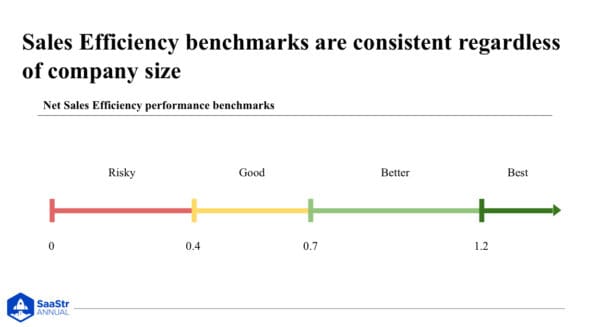
Sales efficiency becomes more important over time. It’s a huge percentage of spend so optimizing is key. You want to see about .7 or better to stay on that IPO path. However, this doesn’t change with company size. So, whether you’re $1M, $20M, or $40M, you want around .7 in net sales efficiency.
For churn, investors focus on gross annualized churn; somewhere in that 10% to -10% range is where you want to be and no worse than that. You can make up for it in upsells, but upsells only take you so far. Keep it so that no more than 10% of your ARR goes away from year to year.
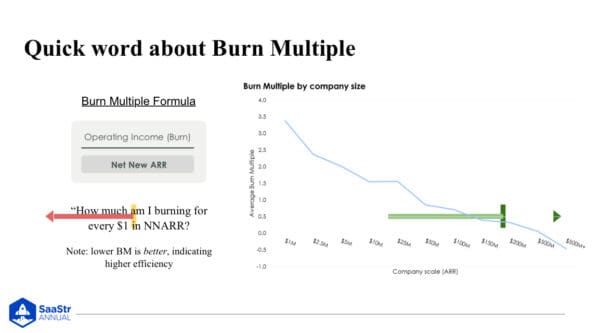
The last vital sign is your burn multiple, which look at overall operating expense efficiency. Your burn multiple is your operating income (burn) divided by net new ARR in that given quarter. Overtime that comes down, but you still want to optimize it.
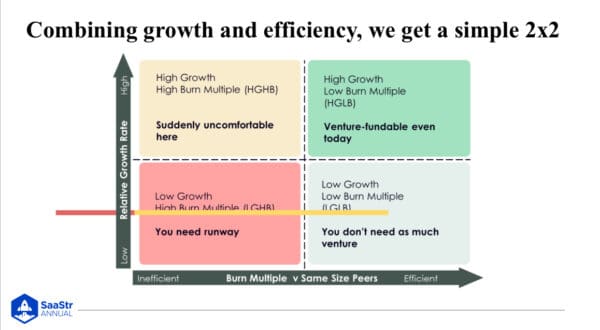
In this 2×2 chart, we’re taking growth rate and burn multiples to see what works and what doesn’t. Green is where you want to be, with high growth and low burn.
Over the last couple of years, we saw a lot more companies in the yellow box, where they grew crazy fast but were also spending a ton. It was a world where capital was easily accessible, and raising money at high valuations was easy.
That’s an ok strategy if you have a line of sight to the next capital. In today’s market, many companies in the yellow box have moved down to the red box, where growth fell off a cliff. They still had a high burn rate.
In the later-stage venture market today, companies are rapidly trying to get to that gray box by lowering their spend, even though growth might take a hit. It means they’ll survive and maybe have a chance to move back up to the green box again.
Two Case Studies
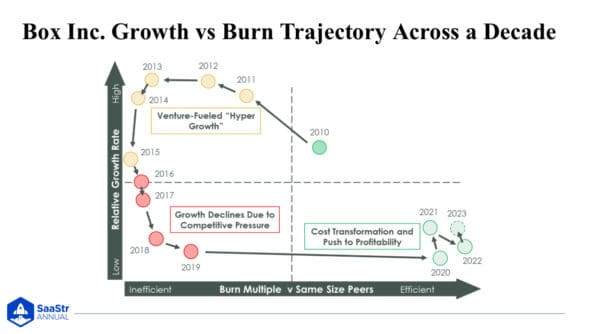
Scale Ventures invested in Box in 2010 while in the high-growth, low-burn bucket. They only raised about $15-20M at that point. After that, they raised a ton of money because capital was cheap and available. Their burn rate went up, and so did their growth rate.
They were in the hyper-growth, hyper-spend category. Then, the market became very competitive while they were a public company. Growth fell, but burn was still high, so they spent about three years in that red box. Finally, they managed to move over to the lower growth but low burn place, and we’re repeatedly seeing this pattern play out in private markets.
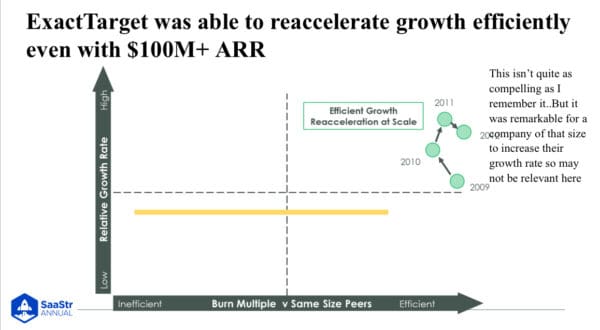
ExactTarget’s chart doesn’t look quite as compelling as Box’s. It was an email marketing company acquired by Salesforce for $2.5B. They tried to go public in the last recession and couldn’t raise money, so they hung out in the gray area with great sales efficiency.
Scale Ventures invested because they thought ExactTarget could accelerate their growth if they put a little more money into sales and marketing. They were a company with a $75M run rate and 30% growth and declining.
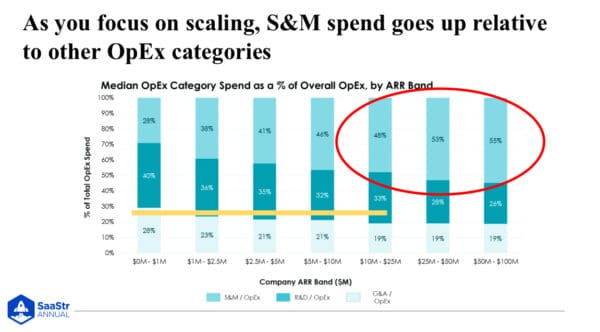
They took capital from VCs, invested it in sales and marketing, and saw their growth rate move to 55%. In a few years, you might see companies hanging out in the gray with efficient sales metrics that can raise and push themselves back into a higher growth box.
One of the Easiest Things to Fix is Sales Efficiency
The bulk of your spend is going to sales and marketing once you’re a $10M company. You can only cut the product so much, but you can optimize sales efficiency by ensuring rep productivity. If you do not see that .7 or better, you should cut back on your spend to achieve that, depending on your organization.
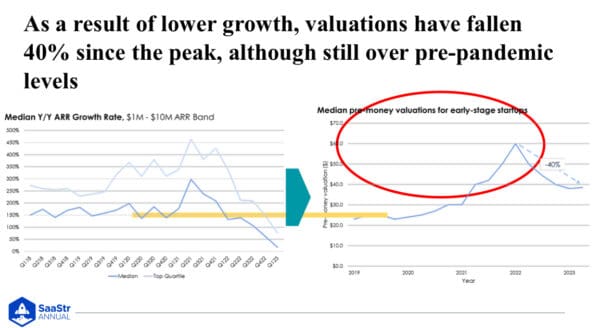
As a result of lower growth, valuations have fallen 40% since the peak, although we’re still over pre-pandemic levels. Funding is still happening, although not to the same degree, so if you’ve got something good, money is out there.
Key Takeaways
- You made it to Series B! You’re 99% likely to have an exit at this point. Only 10% are IPOs, but 99% will have an exit.
- Growth rapidly falls off after the seed stage as companies grow ARR. You can’t triple forever. But there is that minimum level of growth you need to keep attracting venture funding.
- Late-stage companies spend significantly more on S&M than early-stage companies. It’s important to optimize that as you build a big company.
- Efficient growth is critical to surviving in today’s venture market. You want to lower your burn multiple and ensure you have cash.
- Growth trends are returning to normal from post-pandemic peaks. 2021 was abnormal, and today is much more normal.
- There’s still plenty of capital actively investing. You can raise money, so pay attention to those metrics for growth and efficiency.